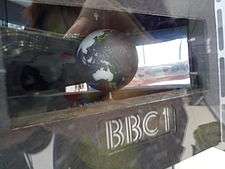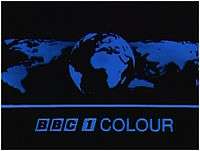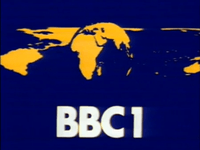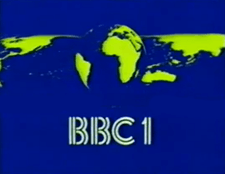Noddy (camera)
Noddy was a camera system used for generating identifications for the BBC1 and BBC2 television networks from 1963[1] to February 1985.





The Noddy video camera was servo-controlled to pan and tilt ('nod') across a matrix of pre-arranged physical objects - captions and mechanical models. The camera was black-and-white, with electronically synthesised colour added to its output. This system eliminated the delay associated with swapping graphics upon a conventional copy stand. It also allowed for the depth required by mechanical objects such as clocks and a rotating globe.
History
The BBC first employed the system in the 1960s, before the advent of colour.[1] The system's remote operation allowed the operator to control it with ease, and allowed the idents to be of no fixed length as the clock symbols could continue for many minutes at a time. A smaller black and white camera was introduced as camera technology progressed and, from 1969, a process was introduced to add colour signals to the camera output. This electronic addition of colour was convenient and made the networks' rebrands easy to perform.[2][3]
The BBC1 mirrored globe
The most famous idents of the Noddy system were the BBC1 mirrored globes used between 1969 and 1985, albeit with minor colour changes. The system machinery consisted of an internally lit, rotating globe in front of a concave mirror. The oceans were painted onto the globe in metallic black paint, leaving the land masses as unpainted patches.[2] The original globe ident introduced on 15 November 1969 featured blue continents and legend against a black background.[3][4][5] The legend included the word 'COLOUR' after the BBC1 corporate logo, to identify the new programme format and act as an advertisement to the vast majority of viewers, still watching in black and white: the colour version of the television licence which financed the BBC was much more expensive.[3][4] The colours of blue and black were chosen because they were still easily distinguishable to those with black and white televisions.[3][4] Another version of the globe without the 'Colour' legend was used before black-and-white programmes, of which there were still many in the BBC1 schedule in the early 70s.[6]
The globe ident was modified in January 1972 to include a new BBC logo with rounded corners and an italic serif font for the 'Colour' legend.[3][4] On 28 December 1974 the ident was reworked further, with yellow continents over a dark blue background and the term 'COLOUR' removed. The legend BBC1 was rendered in white, using a heavy weight of the Futura typeface.[2][3][5] On 5 September 1981, the display was altered to green continents over a dark blue background with a double striped BBC1 legend in white.
The globe model in the machinery was altered over the years as it had to be frequently re-painted. This led to a number of odd variations: the tip of South Africa, the Cape Fold Mountains was pointed in some 1981 models and the Pacific islands more pronounced in others.[3][7]
In 2014 the mirrored globe was added to the BBC's A History of the World object collection.[8]
On 13 November 2017 the "1981" globe was returned for BBC Children in Need "Rocks the Eighties".
Other Idents
A number of other presentational devices were used, the main one of these being the analogue clock. To allow enough light onto the model, a light was fixed onto the camera to shine onto the clock and other idents; this light was not used on the main ident however, which was internally lit; in any event, the mirrored background would have reflected the external light back at the camera and caused glare. The clock was mechanical, and featured numerals indicated by double lines that increased in thickness the further round the clockface. The clock also featured a 'polo' mint centre. The clock is quite distinctive, and became strongly associated with the BBC. The clock's colour and legend never differed from that of the main ident.[2][3][4]
The mechanical clock was abandoned in December 1981 in favour of a computerised clock - except in Wales and Scotland, which retained the mechanical clock until 1985 and Northern Ireland, which retained theirs until 1984, making it the last BBC1 mechanical clock. A rebranding happened the same year. It was the longest running clock of 1974 and 1985 in Wales and was the last region to adopt the computerised clock and preserved the polo dot. Following BBC2's rebrand to the electronic striped 2 ident, technicians started working on an electronic clock to accompany the new look, and following its completion it was this that replaced the mechanical version. The new clock featured a single uniform line thickness all the way round, except at 12, 3, 6 and 9 where the lines were doubled. The polo mint centre was also removed in favour of a central dot.[3][7]
The looks were also accompanied by static programme captions. The captions for the 1969 to 1974 look used the legend of the ident at the bottom of the screen.[9] They continued for a while after the new BBC1 logo was introduced. However, the style was changed in 1981 to feature a banner at the top of the image featuring double striped lines and the double striped BBC1 logo. This design was used until February 1985.[10]
Christmas Idents
| Title | Air dates | Description |
|---|---|---|
| Sequin Model Globe | Christmas 1969 | A spinning globe appears behind the holographic sequins in the background. The caption reads 'Christmas in Colour' with BBC1 logo on the bottom/. |
| Snowflake Model Globe | Christmas 1970 | The previous version is used, but with the sequins replaced by snowflakes. A different caption reading 'Christmas On BBC1' is displayed below. |
| Snowflake Model Globe | Christmas 1971 | The previous version is used, although the caption's font is changed slightly. |
| Snowflake Model Globe | Christmas 1972 | The previous ident is used once more, although with a different caption reading 'Christmas Colour'. This is the first year where the clock is themed as well. |
| Carol Singers | Christmas 1973 | A group of rotating Victorian carol singers encourage us to join them in celebrating Yuletide. The caption reverts to 'Christmas on BBC1', although the font has changed once more. |
| Snowflake Model Globe | Christmas 1974 | The 1971 ident is reused, and is untouched. |
| Snowflake Model Globe | Christmas 1975 | This was the last year to use the same model globe used for the previous idents. The caption is changed with "CHRISTMAS" on the top in a themed font, and the striped BBC1 logo on the bottom. |
| Giant Snowflake | Christmas 1976 | This ident features a large revolving snowflake, and the holographic snowflakes in the background are now red. The same caption as last year is also used, although the 'Christmas' is now red. A clock version of this ident was also used. |
| Christmas Pudding | Christmas 1977 | The globe is a pudding covered with cream with a spring of holly atop of it. This ident used the mirror that the main ident used. Once more, the same caption is used as last year. |
| Double Faced Santa Head | Christmas 1978 | A double-faced Santa Claus head replaces the globe. Snow falls next to the head, and the caption features CHRISTMAS in a large red font and the striped BBC1 logo on the bottom. |
| Carol Singers | Christmas 1979 | Similar to 1973, a group of rotating Victorian carol singers encourage us to join them in celebrating Yuletide. The caption reads 'Christmas BBC1', in a generic font. |
| Victorian Skaters | Christmas 1980 | Four Victorian skaters whirl around a snowman. This was the first Christmas ident used by the BBC to feature a day and night variation. The 'CHRISTMAS' part of the caption is in a similar font to the 1978 ident. |
| Globe Baubles | Christmas 1981 | This ident features the globe becoming a series of multi-coloured baubles. |
| Snowflake | Christmas 1982 | This ident shows a snowflake, with rotating separate parts and the BBC1 caption in a festive font in the middle. |
| Christmas Cylinder | Christmas 1982 (Scotland) | A cylinder shape with Christmas designs resolves behind the globe mirror. The 'BBC1 Scotland' caption appears in its normal striped font. |
| Holographic and Colourised Snowflake | Christmas 1983 | BBC1 modified last year's snowflake by making it holographic and colourised. The caption is changed to the standard BBC1 striped logo at the time, with a rounded box in the middle. |
| Glass Table | Christmas 1983 (Scotland) | A glass table of sorts rotates with tinsel on the top. The 'BBC Scotland' caption is in the normal striped font. |
| Snowpeople | Christmas 1984 | The ident shows two jolly snowmen and a snow woman armed with Christmas crackers. The backcloth colour changed for daytime, evening or night-time. On its last transmission, a full moon was shown in the background. |
| Rotating Cones | Christmas 1984 (Scotland) | We see 3 red cones, with green stripes, rotating on a turntable being reflected by the mirror on the back. The 'BBC Scotland' caption is in red. |
Replacement
The mirrored globe was retired at 7 p.m. on 18 February 1985, with the first showing of the globe's replacement: the Computer Originated World or COW for short. The globe was retired because of the fact it was the only live mechanical model used on television and the maintenance required was making it difficult to use; even the 1981 rebrand caused a number of difficulties such as bad positioning, odd colours and other errors. The globe was also becoming old fashioned, due to its long service since the introduction of colour.[3][11]
The Noddy system was abandoned with the globe, as all idents and clocks were now electronically generated, and as a result the equipment was not needed. Slide scanners were still used for the live origination of programme slides until the late 1980s, when the programme slides then became stored electronically.[12]
NODD
The acronym NODD was first recorded in a web forum related to TV presentation, where an author unconnected with the BBC claimed it stood for Nexus Orthicon Display Device.[2] However, the term is not recognised among the many surviving Presentation and Engineering staff who worked with the system and internal BBC paperwork of the era specifically refers to the camera system as "Noddy".
Presentation's "Noddy" camera also had a companion, originally named "Big Ears", which was a dual monochrome slide scanner, thus allowing in-vision changes between slides. With the advent of colour this was replaced with a Rank Cintel slide scanner, electronically similar to a flying spot telecine machine.
References
- Kempton, Martin. "BBC Television Centre". History of Television Studios in London. TV Studio History. Retrieved 19 September 2011. A detailed account of the history of BBC Television Centre including a brief look at Presentation and the Noddy system.
- Luxton, Simon. "1974 Idents". TVARK. Retrieved 19 September 2011. Videos of the yellow Noddy globe and a detailed description of the system, including behind the scenes pictures.
- Wiseman, Andrew. "BBC Logo Gallery". 625: Andrew Wiseman's Television Room. Retrieved 19 September 2011. Contains behind the scenes images and brief account of the NODD System and globes.
- Luxton, Simon. "1969 Idents". TVARK. Retrieved 19 September 2011. Contains videos of BBC idents from the time.
- "In pictures: History of BBC One globes". BBC News. 28 March 2002. Retrieved 24 June 2012.
- Jeffrey, Dave. "More Flash Files". 625: Andrew Wiseman's Television Room. Retrieved 19 September 2011. Contains a flash recreation of the Black and White Schools ident, based on authentic recordings.
- Luxton, Simon. "1981 Idents". TVARK. Retrieved 19 September 2011. Contains videos and images of BBC1 Idents.
- "BBC Revolving World". A History of the World.
- Luxton, Simon. "1969 Continuity". TVARK. Retrieved 19 September 2011. Conatains images and videos of BBC1 continuity.
- Luxton, Simon. "1974 Continuity". TVARK. Retrieved 19 September 2011. Contains videos of BBC Continuity between 1974 and 1981.
- Luxton, Simon. "1985 Idents". TVARK. Archived from the original on 18 March 2012. Retrieved 19 September 2011.
- Luxton, Simon. "1985 Continuity". TVARK. Archived from the original on 5 May 2012. Retrieved 19 September 2011.
External links
| Preceded by BBC One Pre-1969 Idents |
BBC television idents 15 November 1969 – 18 February 1985 |
Succeeded by BBC One 'COW Globe' ident |